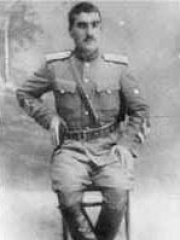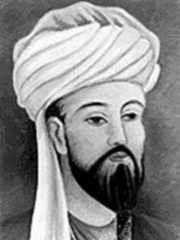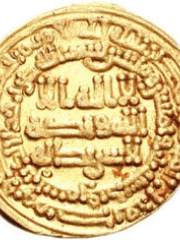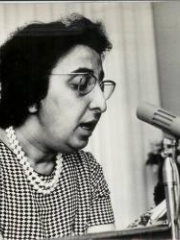



The Most Famous
SOCIAL ACTIVISTS from Iraq
This page contains a list of the greatest Iraqi Social Activists. The pantheon dataset contains 538 Social Activists, 5 of which were born in Iraq. This makes Iraq the birth place of the 26th most number of Social Activists behind Ireland and Canada.
Top 5
The following people are considered by Pantheon to be the most legendary Iraqi Social Activists of all time. This list of famous Iraqi Social Activists is sorted by HPI (Historical Popularity Index), a metric that aggregates information on a biography’s online popularity.

1. Mustafa Barzani (1903 - 1979)
With an HPI of 65.48, Mustafa Barzani is the most famous Iraqi Social Activist. His biography has been translated into 31 different languages on wikipedia.
Mustafa Barzani (Kurdish: مەلا مستهفا بارزانی, romanized: Mustafa Barzanî; 14 March 1903 – 1 March 1979), also known as Mela Mustafa (Preacher Mustafa), was a Kurdish leader, general and one of the most prominent political figures in modern Kurdish politics. In 1946, he was chosen as the leader of the Kurdistan Democratic Party (KDP) to lead the Kurdish revolution against the Kingdom of Iraq. Barzani was the primary political and military leader of the Kurdish revolution until his death in March 1979. He led campaigns of armed insurgency against both the Iraqi and Iranian governments.

2. Rashid ad-Din Sinan (1130 - 1192)
With an HPI of 61.11, Rashid ad-Din Sinan is the 2nd most famous Iraqi Social Activist. His biography has been translated into 18 different languages.
Rashid al-Din Sinan (Arabic: راشد الدين سنان Rāshid ad-Dīn Sinān; 1131/1135 – 1193) also known as the Old Man of the Mountain (Arabic: شيخ الجبل Sheikh al-Jabal; Latin: Vetulus de Montanis), was an Arab Muslim missionary (dāʿī) who served as the leader of the Nizari Ismaili state and the Order of Assassins from 1162 until his death in 1193. An adherent of Nizari Ismailism, a branch of Shia Islam, he was a prominent figure during the Crusades.

3. Al-Mu'tazz (847 - 869)
With an HPI of 58.22, Al-Mu'tazz is the 3rd most famous Iraqi Social Activist. His biography has been translated into 25 different languages.
Abū ʿAbd Allāh Muḥammad ibn Jaʿfar (Arabic: أبو عبد الله محمد بن جعفر; 847 – 16 July 869), better known by his regnal title al-Muʿtazz bi-ʾllāh (المعتز بالله, "He who is strengthened by God") was the Abbasid caliph from 866 to 869, during a period of extreme internal instability within the Abbasid Caliphate, known as the "Anarchy at Samarra". Originally named as the second in line of three heirs of his father al-Mutawakkil, al-Mu'tazz was forced to renounce his rights after the accession of his brother al-Muntasir, and was thrown in prison as a dangerous rival during the reign of his cousin al-Musta'in. He was released and raised to the caliphate in January 866, during the civil war between al-Musta'in and the Turkish military of Samarra. Al-Mu'tazz was determined to reassert the authority of the caliph over the Turkish army but had only limited success. Aided by the vizier Ahmad ibn Isra'il, he managed to remove and kill the leading Turkish generals, Wasif al-Turki and Bugha al-Saghir, but the decline of the Tahirids in Baghdad deprived him of their role as a counterweight to the Turks. Faced with the assertive Turkish commander Salih ibn Wasif, and unable to find money to satisfy the demands of his troops, he was deposed and died of ill-treatment a few days later, on 16 July 869. His reign marks the apogee of the decline of the Caliphate's central authority, and the climax of centrifugal tendencies, expressed through the emergence of the autonomous dynasties of the Tulunids in Egypt and the Saffarids in the East, Alid uprisings in Hejaz and Tabaristan, and the first stirrings of the great Zanj Rebellion in lower Iraq.

4. Al-Shaykh Al-Mufid (948 - 1022)
With an HPI of 57.24, Al-Shaykh Al-Mufid is the 4th most famous Iraqi Social Activist. His biography has been translated into 18 different languages.
Abu 'Abd Allah Muhammad ibn Muhammad ibn al-Nu'man al-'Ukbari al-Baghdadi, known as al-Shaykh al-Mufid (Arabic: الشیخ المفید) and Ibn al-Mu'allim (c. 948–1022 CE), was a prominent Twelver Shia theologian. His father was a teacher (mu'allim), hence the name Ibn al-Mu'allim. The title "al-Mufid" was given to him either by Muhammad al-Mahdi, the twelfth Shia Imam, or by al-Rummani, a Sunni scholar, after a conversation with him. The leader of the Shia community, he was a mutakallim, theologian, and Shia jurist. He was taught by Al-Shaykh al-Saduq, Ibn Qulawayh, Abu Abdallah al-Basri and al-Rummani, and Sharif al-Murtaza and Shaykh Tusi were among his students. Only 10 of his 200 works have survived, among which are Amali, Al-Irshad, Al-Muqni'ah, and Tashih al-Itiqadat.

5. Naziha al-Dulaimi (1923 - 2007)
With an HPI of 49.10, Naziha al-Dulaimi is the 5th most famous Iraqi Social Activist. Her biography has been translated into 26 different languages.
Naziha Jawdet Ashgah al-Dulaimi (1923 – 9 October 2007) was an early pioneer of the Iraqi feminist movement. She was a co-founder and the first president of the Iraqi Women's League, the first woman minister in modern Iraq history, and the first woman cabinet minister in the Arab world.
Pantheon has 5 people classified as social activists born between 847 and 1923. Of these 5, none of them are still alive today. The most famous deceased social activists include Mustafa Barzani, Rashid ad-Din Sinan, and Al-Mu'tazz.
Deceased Social Activists
Go to all Rankings
Mustafa Barzani
1903 - 1979
HPI: 65.48
Rashid ad-Din Sinan
1130 - 1192
HPI: 61.11
Al-Mu'tazz
847 - 869
HPI: 58.22
Al-Shaykh Al-Mufid
948 - 1022
HPI: 57.24
Naziha al-Dulaimi
1923 - 2007
HPI: 49.10






